David has many years of experience in teaching and leading workshops.
Explore below to learn more about special topics he might bring to your event.
Fee support for David Millstone may be available to nonprofit organizations through the New England States Touring (NEST) program of the New England Foundation for the Arts. Visit www.nefa.org for more information.
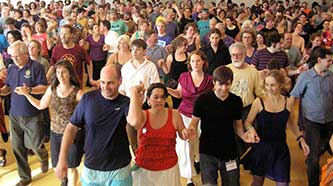
American
We’ll explore the evolution of the longways dance form over two centuries: stately triple minors, duple minor proper, duple improper dances with increasing degrees of activity for all dancers, and the Becket formation. Can be as short as one workshop session or expanded to cover an hour a day for a full week. (This version was recently billed as “Dancing Through Time.”)
This session showcases the dances that brought new figures into an expanded contra repertoire. The process goes back decades, but the 1970s and 1980s saw a dramatic increase in these changes. Becket formation, Petronella twirls, weave the line, star thru, square thru, poussettes, Mad Robin, double progression– these are just some of the innovations we’ll explore.
 Until recently, before the explosion of new dances written in the last twenty-five years or so, the core of the contra dance repertoire included a small group of dances, some of which go back 200 years. Most have an associated tune. I’ll introduce dances that are explored in Cracking Chestnuts, a CDSS publication I co-authored that looks at these classics of the repertoire. This session can be done with live music, if the musicians know the necessary tunes, or with recordings.)
Until recently, before the explosion of new dances written in the last twenty-five years or so, the core of the contra dance repertoire included a small group of dances, some of which go back 200 years. Most have an associated tune. I’ll introduce dances that are explored in Cracking Chestnuts, a CDSS publication I co-authored that looks at these classics of the repertoire. This session can be done with live music, if the musicians know the necessary tunes, or with recordings.)
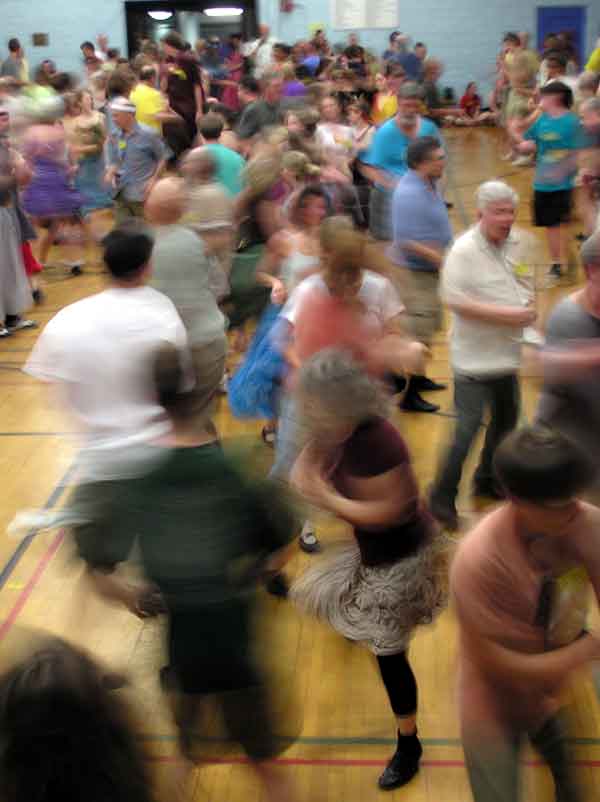 Contemporary fast-moving contras!
Rip-snortin’ squares!
Stately chestnuts!
Double quadrilles, triplets, and an occasional couple dance!
Sounds like fun? You betcha
Contemporary fast-moving contras!
Rip-snortin’ squares!
Stately chestnuts!
Double quadrilles, triplets, and an occasional couple dance!
Sounds like fun? You betchaThe phrase is Ralph Page’s, and the workshop showcases more elegant dances from our repertoire, both old and new. Can be an English & American session if the musicians are able to play for ECD, or it can focus solely on American style dances– contras, squares, double quadrilles, couple dances.
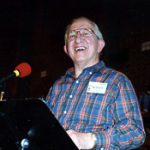 Ted Sannella was a modern-day dance master, an internationally-recognized leader whose many compositions illustrate the variety possible in creating dances within the New England dance tradition. This session will showcase examples of Ted’s choreographic genius: contras, squares, triplets, and a mixer or two in other formations.
Ted Sannella was a modern-day dance master, an internationally-recognized leader whose many compositions illustrate the variety possible in creating dances within the New England dance tradition. This session will showcase examples of Ted’s choreographic genius: contras, squares, triplets, and a mixer or two in other formations.
Inspired in 1968 by the English country dance Fandango, Ted Sannella created 41 triplets, mini-contra dances for sets of three couples in which a new couple becomes active each time through. From simple to complex, Ted’s Triplets offer wide variety for today’s dancers.
Ted Sannella created the contemporary triplet for contra dance, but in the years since his death, others have started to explore the choreographic possibilities of this formation. In this session, we’ll sample some contemporary triplets, ranging from simple to more complex.
Gene Hubert was an innovative, prolific and influential choreographer, widely credited with introducing the concept of “flow” into the contra dance world. Starting in the 1980s, Gene’s dances incorporated heys, gypsies, and other figures to enrich the repertoire. This session can focus just on contras or can include squares as well.
Challenging, yet satisfying, contras, squares and triplets, aimed for experienced dancers. This session will showcase material that stretches dancers’ brains and bodies a bit. In some cases, these are dances that involve unusual figures; others demand precise timing with little room for recovery.
The last 40 years have seen an explosion of creativity in the contra dance world, as hundreds of new dances have appeared that stretch the boundaries set by more traditional dances. We’ll look at new figures and old figures being used in new ways. Each dance will be by a different choreographer as we work our way through the decades. For a more particular focus, we can dance the very first instances of new figures being used in a contemporary contra dance.
Double progressions, double contras, double quadrilles, double crossing…
Triple minor contras, triple progression contras, squares with groups of three on each side, dances in triangle formation, triplets, three-facing-three circle dances, triplets, maybe a dance in waltz time, etc.
Although a challenging new idea in the early 1980s, the hey for four is now well established in the contra repertoire. But wait! There’s more! This workshop will showcase some of the many other varieties of this weaving figure—heys for three, six, and eight, as well as push-back / ricochet heys, diagonal heys, heys in square dances, dolphin heys… it’s an exciting list! If desired, we can also look at heys in English country dances.
 Some are simple, high-energy dances that put the grin on everyone’s face; some are more complex figures that delight experienced dancers. There’ll be older classics, singing squares, squares representing different regional traditions, and squares from the “golden age” of the 1950s.
Some are simple, high-energy dances that put the grin on everyone’s face; some are more complex figures that delight experienced dancers. There’ll be older classics, singing squares, squares representing different regional traditions, and squares from the “golden age” of the 1950s.
Texas and the American Southwest created an exciting style of square dance featuring high-energy dances set to fast tunes. Callers took figures from Southern Appalachian dance and boosted the activity level to involve more dancers moving more of the time. Some of these dances were at the heart of the square dance explosion of the 1950’s.
Most dances on today’s programs are duple improper or Becket formation contras, plus—depending on your locale and the caller—a mix of square dances. In recent years, choreographers have used those same basic moves, and a few variations, in wildly creative ways. In this session, each dance will be in a different formation. For that matter, there are enough well-crafted examples—from simple to complex—that we could easily spend a week exploring dances in odd formations.
Triple minor dances (“Hands six”) have been an integral part of American country dance, but are unfamiliar to most of today’s dancers. We’ll explore examples from two centuries ago as well as newer compositions, including both simple and complex choreography, elegant to lively. The session could include the classic Money Musk, perhaps the most famous contra dance of all time.
Like the English language itself, contra dancing has grown by absorbing other cultures. These contras include figures that originated in such diverse traditions as English country dances, Appalachian mountain square dances and modern western square dances.
This workshop focuses less on what we are dancing (the figures) but instead concentrates on how we dance. Attention to small details can dramatically improve the experience for dancers, our partners, and our neighbors. Caution: the alternate title of the session is “David’s Pet Peeves.”
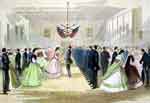 An introduction to mid-19th century dance, including quadrilles, contras and couple dances, along with some guidelines about appropriate social etiquette for a public dance. All dances for the program are ones enjoyed by dancers at that period.
An introduction to mid-19th century dance, including quadrilles, contras and couple dances, along with some guidelines about appropriate social etiquette for a public dance. All dances for the program are ones enjoyed by dancers at that period.
On a per capita basis, there are more folks enjoying traditional American squares and contras in Denmark than anywhere else. Out of a country of 5.5 million people, there are more than 50 working callers at any given time, and some 500 people have been trained as callers over the past 35 years. This workshop features dances written by contemporary Danish choreographers, including contras, squares, triplets, and mixers.
Contras split off from longways English country dance roughly two hundred years ago. Recent decades have seen a re-anglicization of contemporary contras, starting with the introduction of heys and gypsies in the 1970s and 1980s. More recently-composed contras include other figures borrowed back from English country dance.
English Country Dance

This is an introduction to English country dance, building on participants’ experience with other dance forms. We’ll introduce basic figures along with tips on styling, with dances selected from 350 years of country dance history.
English country dance offers extraordinary variety: formations, meter, tempo, energy level. We’ll pay particular attention to these variables and how our bodies (and brains) respond to each. At the same time, we’ll explore more subtle aspects of English country dance style.
 In the first edition of Playford in 1651, only about one-third of the dances were “longways for as many as will.” Drawing from old and new compositions alike, we’ll examine some of the many other possibilities, including set dances for two, three, four, and more couples that allow for extraordinary choreographic variety.
In the first edition of Playford in 1651, only about one-third of the dances were “longways for as many as will.” Drawing from old and new compositions alike, we’ll examine some of the many other possibilities, including set dances for two, three, four, and more couples that allow for extraordinary choreographic variety.
English dance for all, with an emphasis on classics from the English country dance. Intermediate level dances, with just enough teaching to get each dance started—our primary focus is simply to provide opportunities to dance to great music.
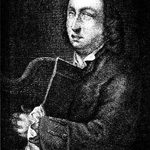 More English country dances have been set to works by the great Irish harpist Turlough O’Carolan, than to any other classical composer’s tunes, except for the famed Anon. This session will explore some of this vast modern dance repertoire set to Carolan’s lovely 18th century melodies; dances range from simple to complex, depending on the skill of the dancers and their desire for challenge.
More English country dances have been set to works by the great Irish harpist Turlough O’Carolan, than to any other classical composer’s tunes, except for the famed Anon. This session will explore some of this vast modern dance repertoire set to Carolan’s lovely 18th century melodies; dances range from simple to complex, depending on the skill of the dancers and their desire for challenge.
With circles and lines and stars, one’s partners or neighbors can lead an unsure dancer; more challenging can be figures with no physical connection, including the many varieties of heys (ranging from a simple hey for three to circular heys to the crossover mirror hey) and moves such as double figure eight. For less experienced dancers, this workshop provides an introduction to the common figures; for more skilled dancers, we will explore figures in less familiar settings.
Heys are weaving figures that come in many forms—straight heys, circular heys, crossover heys, mirror heys, Morris heys, and today’s favorite, the dolphin hey. We’ll look at some basic principles so that everyone is moving, and we’ll explore heys for three, four, and six in settings old and new. If desired, we can also look at heys in American contras and squares.
Aimed at more experienced English dancers, we’ll look at work from gifted choreographers, ranging from Nathaniel Kynaston and Thomas Bray 300 years ago, to 20th century greats such as Pat Shaw, Fried deMetz Herman, and Tom Cook, to contemporaries such as Charles Bolton, Gary Roodman, Philippe Callens, Colin Hume, and a host of others.
The dolphin hey is a relatively recent innovation in dance choreography, a figure that originated in Scottish country dance, moved into English country dance, and thence into contras. We’ll look at the various ways this figure has been used, including both simple and more complex variations.
The last few decades have seen the creation of a vast number of new English country dances. In this session, we’ll focus on some of those new dances. We can look at choreographers on both sides of the Atlantic, or, if desired, concentrate on North American choreographers who are creating English dances. (see the next two topics)
The first session looks at English country dances created in—surprise!—England, including both historical dances and contemporary compositions. The second session focuses on dance compositions from US and Canadian choreographers.
Start with high-energy contras, mix with elegant English country dances, and add squares, triplets and an odd formation for spice, all offered on a tantalizing menu for those who love country dance in all its varied flavors.
Callers' Workshops
For experienced dancers who’d like an introduction to the craft of calling dances. We’ll look in broad terms at the role of the caller, and more specifically how to teach a dance and how to prompt it correctly.
 Weddings, family dances, and many private parties require a different approach and repertoire from the usual program of contras and squares. These gigs can also be among the most satisfying (and lucrative) for callers and musicians. We’ll share tips about how to make these events fun for all while dancing our way through more than a dozen sure-fire examples. To my mind, developing your skills for such audiences is the most difficult (and most important) challenge facing callers.
Weddings, family dances, and many private parties require a different approach and repertoire from the usual program of contras and squares. These gigs can also be among the most satisfying (and lucrative) for callers and musicians. We’ll share tips about how to make these events fun for all while dancing our way through more than a dozen sure-fire examples. To my mind, developing your skills for such audiences is the most difficult (and most important) challenge facing callers.
Squares ARE different, and that’s part of the attraction! Callers who include squares in a program are helping their dancers become stronger, as well as keeping alive a vital part of our dance heritage. Yes, some squares can be more challenging to call, but there are many styles that are as easy to call as contras. Starting with an examination of the relationship of dancers and caller, we’ll look at different kinds of squares and will give participants opportunities to do some calling. We’ll pay particular attention to the common structure of many square dances, and will demystify break figures.
“I really liked your program; it wasn’t just the same kinds of dances we usually get!” This session will explore the many ways that callers can bring variety onto the dance floor. Exercises, work with dance cards, small group activities and discussions with everyone… Participants will come away with tools to help develop more interesting programs.
Aimed at callers with some experience, this session goes beyond the basics to look in depth at several aspects of timing. An allemande left once around can take 4, 6, or 8 counts, depending on context; even such simple figures as down the center and back differ in their timing. This workshop blends exercises, discussion, and lots of dancing to illustrate the various points.
Presentations
In addition to my own four video documentaries, I also can bring selections from dozens of other dance videos, ranging from movies eighty years old to more recent documentary footage. One popular program is “Hollywood Squares,” a one-hour sampler of how traditional dance is presented on the silver screen and on television. Another is a sampler of different square dance styles, both traditional and modern. Videos can be presented in a workshop slot or can be placed into the schedule at odd times. In either case, we need appropriate equipment, either a large-screen television with DVD player or a projector and screen (in a dark room).
Where did contras and squares originate? Why does everyone know what a square dance is but few have ever heard of contras? How did these two dance forms rise and fall in popularity over the centuries? We’ll focus on six major revivals in the 20th century and the key individuals in each, from Cecil Sharp up to Ralph Page and Dudley Laufman. Illustrated with audio clips demonstrating changing styles of calling and music; if the equipment is available and we have time, I will include appropriate video footage. This needs one to three hours; it can also be presented in short segments, such as a brief talk each day of a weeklong camp.
